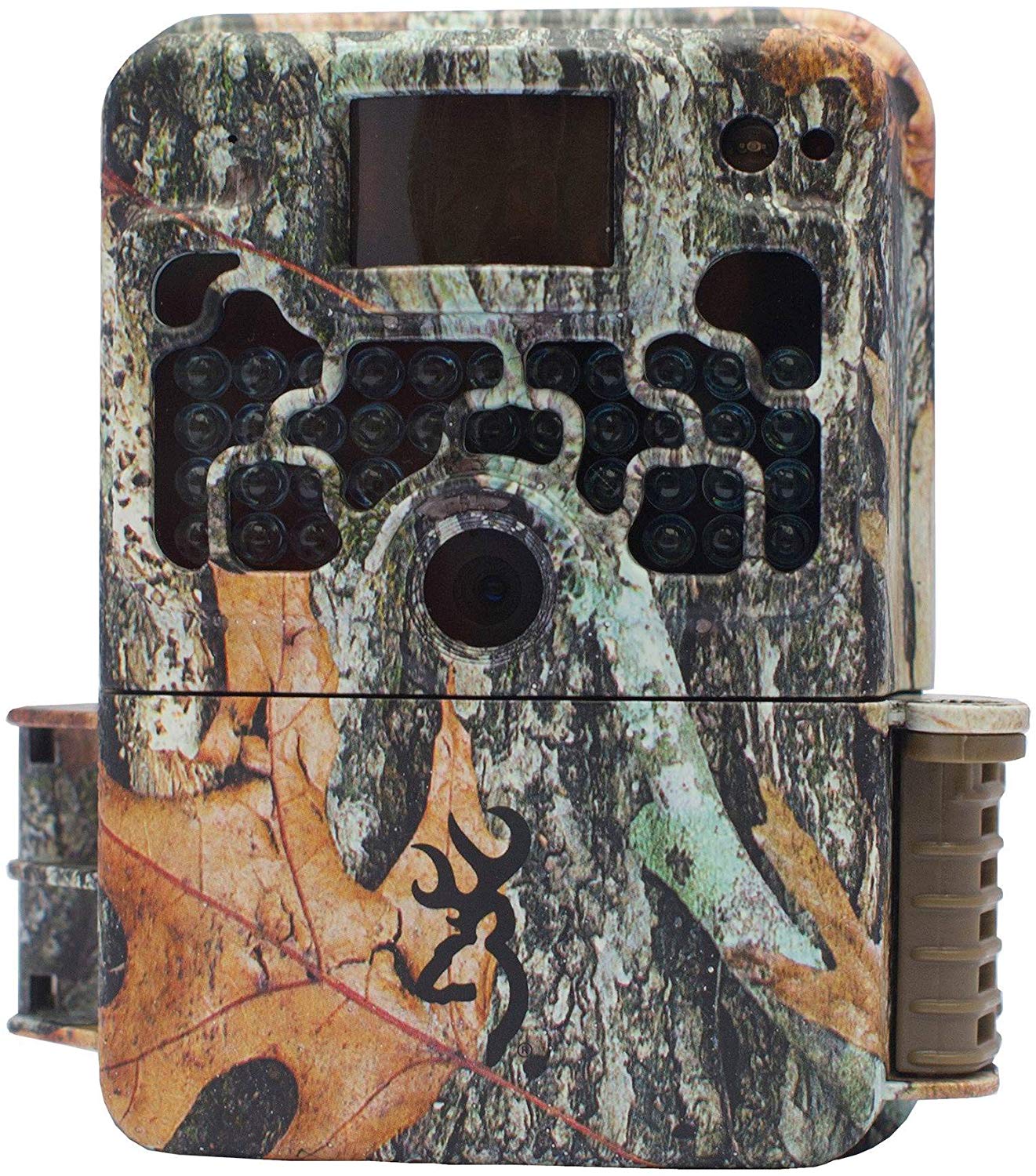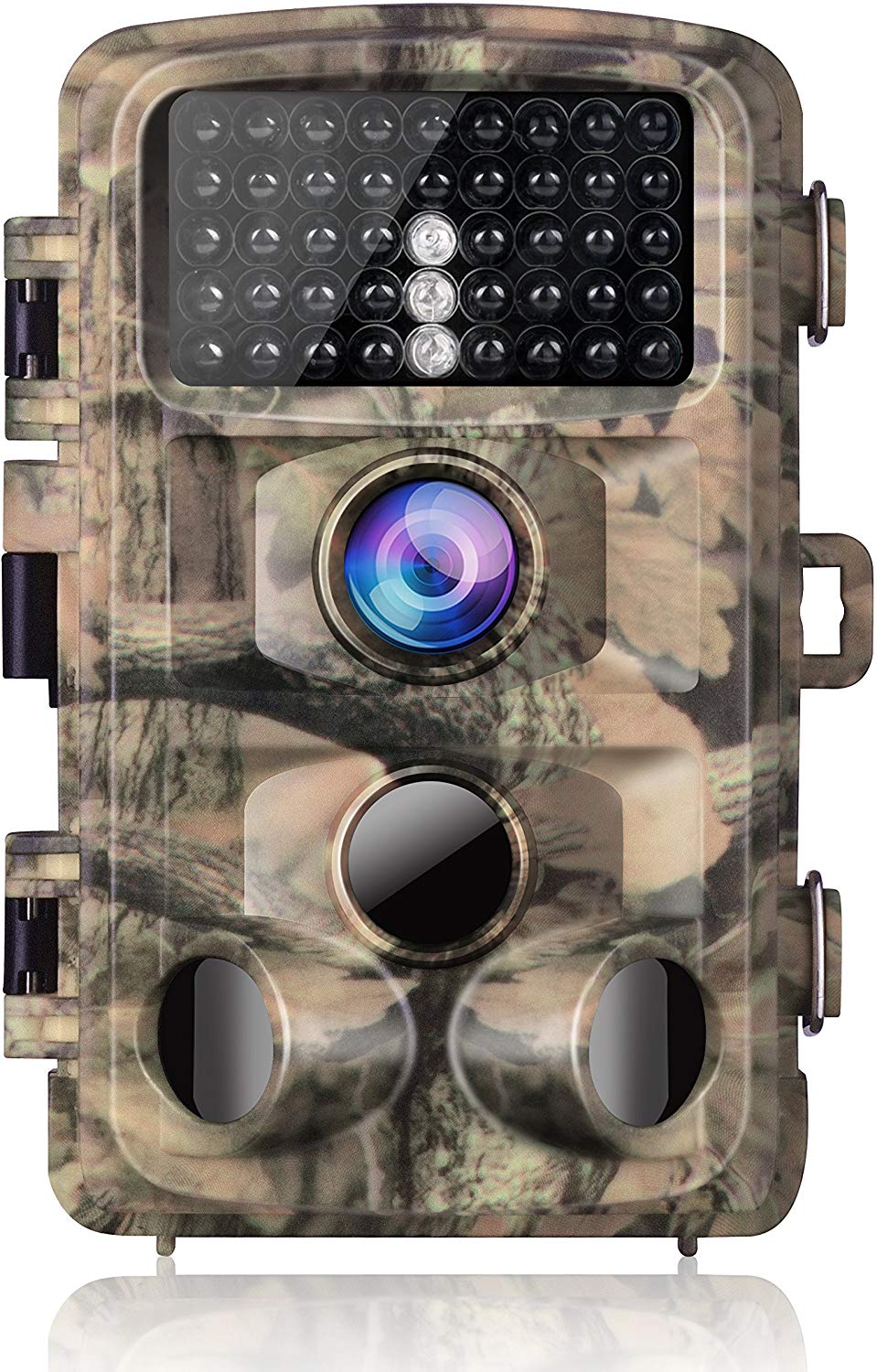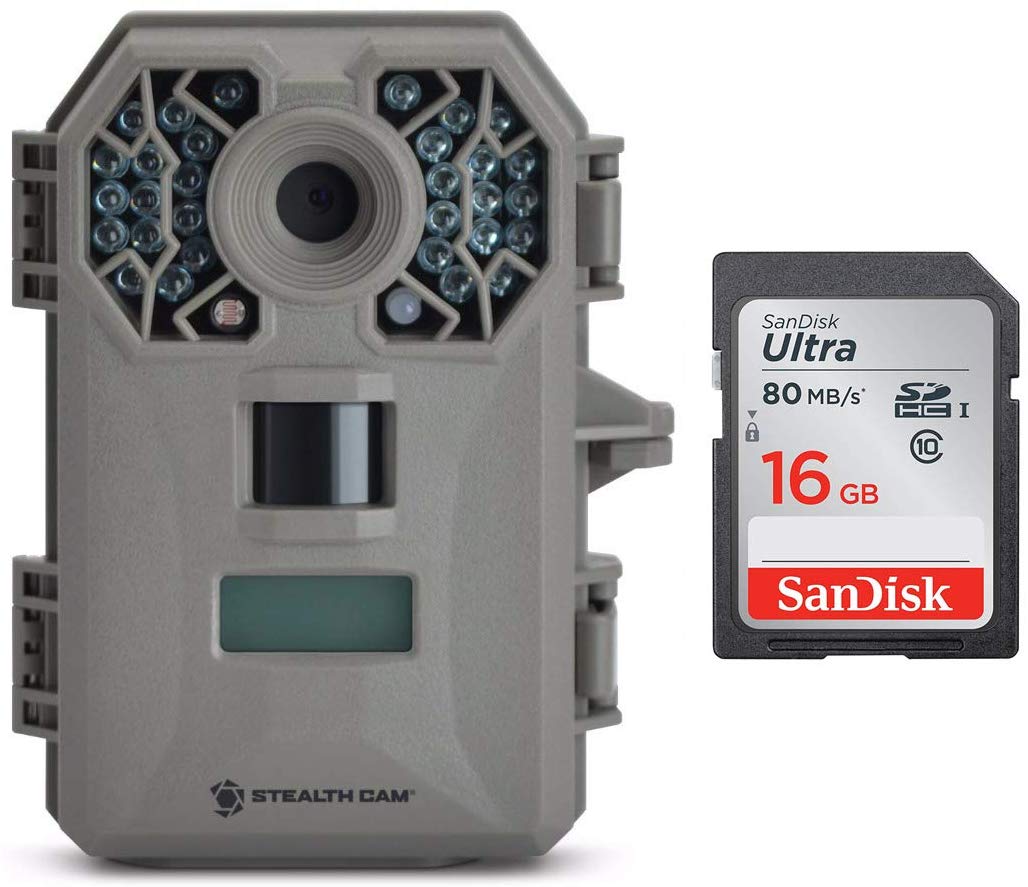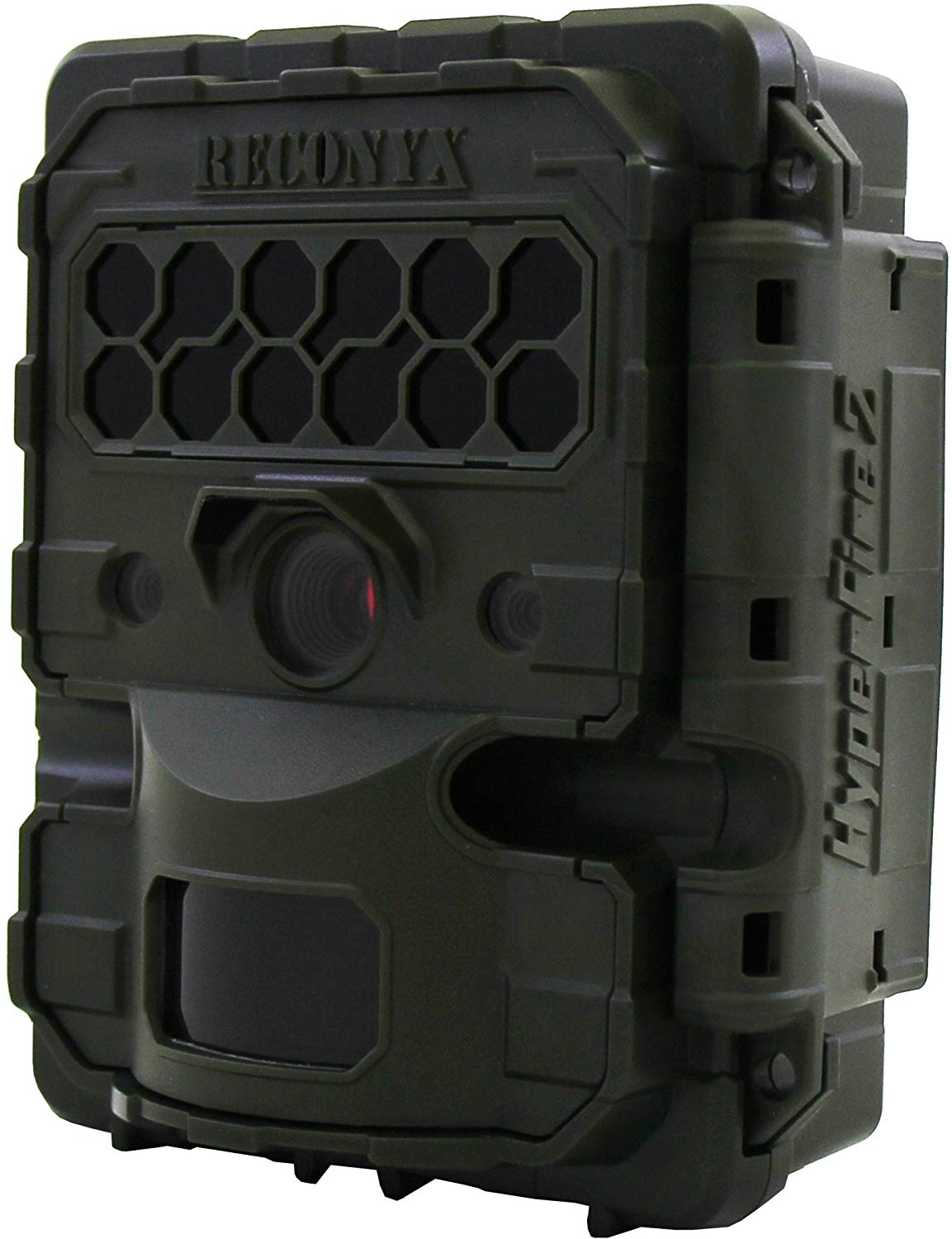Night vision binoculars are becoming increasingly popular for hunting. They’ve been around for several years as the military has relied on them for one mission after another. With hunting, it gives the hunter a real advantage with allowing them to see their target through the blackened forest. Sometimes, the moonlight just isn’t enough to supply the hunter with needed light. Since many hog and varmint hunts are performed at night, the technology of night vision binoculars is a helpful accessory. Continue Reading
Author: james
The Best Pistol Scopes on the Market in 2021
Recreational shooters and handgun hunters have a list of questions to answer when choosing the best scope for their pistols:
- Will you hunt from a stand?
- What is the expected shot length?
- How long is the maximum distance of a shot?
- Will you hunt with dogs?
- How well do you see?
- Will the recoil of the pistol generate abuse to the scope of choice?
Using a scope on a pistol is different than using one on a rifle: 1) there are physical limitations that are not manufactured or design errors; 2) the location of the scope in relation to the shooter’s eye is not the same; 3) the long eye relief of a pistol scope compromises the exit pupil because of light gathering capabilities; 4) without the whole-body support afforded by a rifle, the movement of a hand gun increases; and 5) the wobbles and shakes are exaggerated when looking through a scope, especially one set on a high magnification.
Scoped pistols function best when used with a solid rest, so use a shooting stick or the rail of a stand when hunting blind over bait or from a stand for optimal performance. A benefit of the scope is its magnification, so hunters assess and judge animals in their sights better with scopes. There is also an increase in shooting ability from longer ranges, and target shooters are more accurate shots when utilizing a pistol scope. The scope provides a more precise sighting system.
Once you have determined whether you can mount a scope on your pistol in the first place, check manufacturer information to ensure the scope you choose is compatible with your pistol, the intended use, and the recoil. The arrangement of scopes described here is by price, starting with the most economical and ending with the most expensive recommendation. Included are the retail prices and features of the scopes. Overall, if you’re looking for a quality optic that you will give you maximum clarity on target, you’ll have to spend more money.
Top Pistol Scopes in Different Price Ranges
NcSTAR 2 – 7×32 mm AO Pistol Scope
NcSTAR Pistolero has a pistol scope features a long eye relief that satisfies just about any hunter’s needs. Professional marksmen and target shooters appreciate this scope. This pistol scope was optimally designed for any platform requiring long eye relief.
The duplex reticle of the AIM Sports pistol/scouting scope has a built-in Red Laser and is manufactured with milled aircraft grade aluminum. It is purged and charged with nitrogen to make it fog proof, while a sealing process makes it weather resistant. This scope takes plenty of heavy recoil, and the one-piece design gives the scope its ruggedness. Users can choose between green and red reticles.
Nikon has built a scope with extended eye relief and shockproof optics. This scope takes the recoil from the most powerful pistol calibers. Its ability to handle powerful recoil is only one of its famed features; one can view maximum brightness from sunup to sundown because of the Ultra ClearCoat optical system, or make an on-the-fly adjustment with the quick-focus eyepiece. This reliable Nikon scope is fog proof and waterproof, and it is available in trajectory-compensating and patented Nikoplex reticles.
The Bushnell Trophy is a 2-6x that comes in either silver or black colors. Regardless, both versions have a 20-inch eye relief. Despite their size, the scopes are surprisingly durable, being water, fog, and shockproof to the highest degree.
When operating in the rain, the Trophy can transmit up to 90% worth of light available. Even when conditions aren’t ideal, the Trophy can identify and acquire targets. Bushnell prides itself on making some very durable products, and the Trophy is no exception.
Weaver has a classic gloss, Dual-X scope with a long eye relief that allows efficient use of the firearm at arm’s length. The accuracy of this scope is reliable and repeatable, and its reliability extends beyond accuracy; this rugged piece of equipment handles a tremendous revolver recoil of 1,000 rounds.
The Leupold pistol scope handles the crushing recoil of the magnum and big-bore pistols of today and are available in variable and fixed configurations. Whether you are shooting at a target or opt to hunt game, the noncritical, extended eye relief provides fast target acquisition. These rugged scopes are waterproof and have sight pictures with brightness, contrast, and clarity.
Reason for Pistol Scope Use
Modern pistols operate on extreme ranges, so having a pistol scopes can prove to be very beneficial. Overcoming the lack of trigger control is relatively easy with practice, especially when repetition of the movement can help you develop a reflex. Utilizing a scope emphasizes the user’s mistakes while shooting, so this provides an easy opportunity to identify and correct those mistakes. Accuracy can improve by approximately 20 percent with proper trigger control mastery, so pistol scopes prove to be a worthwhile purchase.
The Best Trail Cameras of 2021
With the advent of modern technology, the trail camera has become a must-have tool for hunting, hiking, and surveying. Also known as game cameras, trail cameras have become so technologically advanced that even outdoor photographers, landscapers, and security-savvy homeowners have begun to invest in these invaluable optical tools. With a host of trail camera options available, however, pinpointing just the right camera is easier said than done. A look at the complete guide to trail cameras can help you select the right device for your outdoor needs.
The Top 10 Best Trail Cameras
1. Browning Strike Force Pro XD Trail Camera
Features and Benefits: The Browning camera is the brainchild of a company that originally specialized in manufacturing firearms, scouting equipment, and hunting tools. With over a century of experience in the hunting business, this company has insider knowledge of what makes a good trail camera. The top features of the Strike Force Trail Camera are the built-in dual lenses. These two camera lenses work together to produce high-quality images 24MP in size. Trigger speed for this camera averages around 0.19 seconds, and it has a power-conservation feature that results in a battery life of approximately 10 months for six lithium batteries.
- Photo Resolution – 24MP
- Video – 1080p HD video with audio
- Trigger Speed – Between 0.15 and 0.22 seconds
- Detection Range – 80 feet
- Flash – Red-Glow Infrared
- Stand-Out Feature – Dual Lenses
Pros:
- Dual Lenses produce stellar picture quality
- High-definition video
- Long battery life
- Fast trigger speed
Cons:
- Short video duration (20 seconds or less)
- Very small camera screen display
- Time and date may be difficult to read due to small display
Features and Benefits: Campark trail cameras are among the most well-known game cameras on the market. Instead of using one passive infrared sensor, this camera uses three. This triple-action capability increases motion sensitivity and results in a trigger speed of 0.3 seconds. It also lessens the amount of battery power needed to activity the camera. The camera takes high-definition video and can also film game at night without scaring off camera-shy species like deer. (Since humans can usually detect the LED lighting, however, this camera may not be suitable for discreet home security.) The camera is compatible with a microSD and has a color display screen.
- Photo Resolution – 14MP
- Video – 1080p HD video
- Trigger Speed – 0.3 seconds
- Detection Range – 65 feet
- Flash – 42 Low-Glow Infrared LEDs
- Stand-Out Feature – Three PIR sensors
Pros:
- Three passive-infrared sensors
- Takes good-quality daytime and nighttime photos
- Attractive camouflage color options
- Waterproof casing
Cons:
- Initial setup may be challenging for beginners
3. Stealth Cam G30 Trail Camera
Features and Benefits: The Stealth Cam with GPS is a no-nonsense device perfect for everyone from beginners to seasoned professional scouts. It has a matrix-blur reduction feature that ensures each 8MP photograph comes out crisp (regardless of angle). Boasting a multi-zone detection feature, this trail camera accurately responds to movement at a trigger speed ranging from 0.5 to 0.75 seconds. The camera’s 30 infrared LEDs provide superb illumination for up to 80 feet in the dark, making this tool perfect for taking nighttime pictures. In addition, another excellent scouting feature is the game camera’s smart GPS capability. The GPS records the exact location of the snapped photograph and it can also notate the location of the camera itself. This way, you can use a handheld hunting GPS if you suspect the camera has been lost or stolen.
- Photo Resolution – 8MP
- Video – HD with Audio
- Trigger Speed – 0.75 seconds
- Detection Range – 80 feet
- Flash – 30 IR LEDs
- Stand-Out Feature – GPS capabilities, matrix-blur reduction, multi-zone detection
Pros:
- Multi-zone, motion-sensor detection
- Matrix-blur reduction
- Pre-configuration settings for beginners
- Clear nighttime photos
- Records HD video with audio
- GPS tagging included
Cons:
- Glowing LED lights may be visible to nearby wildlife
- Slower trigger speed than some models
4. Reconyx HyperFire 2 HF2X Trail Camera
Features and Benefits: At first glance, some of the specs for the Reconyx HyperFire 2 HF2X may seem unusual. Why does an upscale camera have 3MP resolution and 720p video? The reasons for the non-standard specs is that this is not your average camera. Because instead of the usual 32GB to 64GB SD Card storage compatibility, this trail camera can hold an SD card of up to a whopping 512GB in size. The camera also accepts 12 AA batteries that can last up to two years. Given the massive storage capacity and extremely long battery life, the Reconyx is the perfect “set up and go” device. Photos taken with this camera feature excellent visual contrast and sharpness relative to its sharp resolution, allowing you to collect years’ worth of high-quality images with minimal effort. In addition to the excellent storage and setup features, the trail camera uses no-glow, high-output infrared illumination technology. This means that you can capture images up to 150 feet away during the nighttime without any LED brightness scaring away the wildlife away.
- Photo Resolution – 3MP
- Video – 720p with Audio
- Trigger Speed – 0.2 seconds
- Detection Range – 150 feet
- Flash – No-Glow High Output-Covert IR
- Stand-Out Feature – Buckview Advanced Software
Pros:
- Extreme storage capacity
- Extra-long battery life
- Very fast trigger speed
- Superior image quality
- Easy to “set up and go”
- No-glow ifrared illumination for nighttime recording
- Five-year warranty
Cons:
- Video duration maxes out after 10 seconds
Features and Benefits: The Foxelli trail camera is a super stealthy device that takes equally high-quality photos during both daytime and nighttime. Like a sly fox, this game camera can swipe desired information without detection from prey. It features natural camouflage that blends in with tree bark, and its lens snaps high-resolution 14MP pictures. And Foxelli’s video feature is among the most impressive as it can record high-definition 1080p videos of up to 10 minutes long. Because of the lengthy video capacity, the Foxelli trail camera is the go-to device for holistic study of game behavior. The camera also has 42 low-glow LED lights for discreet nighttime recording and crisp daylight photos and video.
Specs:
- Photo Resolution – 14MP
- Video – 1080p
- Trigger Speed – 0.5 seconds
- Detection Range – 65 feet
- Flash – 42 low-glow IR LEDs
- Stand-Out Feature – Super fast PIR motion sensor, excellent night lighting
Pros:
- Can record 1080p HD videos of up to 10 minutes long
- Low-glow infrared illumination technology for steathy day and night recording
- Fast motion sensors
- Excellent natural camo and easy mounting
Cons:
- Display screen is difficult to see under certain lighting
- Keypad is not the easiest to use
Features and Benefits: The Victure HC300 has an innovative design that is sure to make you feel victorious in hunting, gaming, or scouting. It snaps high-quality photos with excellent color contrast, and the camera casing is completely weatherproof. The trail camera also contains 38 no-glow LEDs, making it perfect for capture nighttime photos and videos on your property or on the field.
Specs:
- Photo Resolution – 16MP
- Video – 1080p
- Trigger Speed – 0.5 seconds
- Flash – 38 No-Glow IR LEDs
- Stand-Out Feature – Completely stealth nighttime illumination
Pros:
- Excellent image quality
- No-Glow infrared technology
- HD video quality
- Weatherproof
Cons:
- Fewer frames per second (fps)
- Must open camera cover to access control panel and display screen
7. Moultrie A-40i Trail Camera
Features and Benefits: Moultrie is another highly recognizable brand name in the game camera world. Famous for the production of hunting-specific products like deer bait and squirrel traps, Moutlrie knows exactly what it takes to create a successful trail camera. The Moultrie camera features no-glow, motion-activated LED lights that make it perfect for capturing images and video in the dark. Moultrie devices are also compatible with wireless modems to transfer images or videos across connected networks.
Specs:
- Photo Resolution – 14MP
- Video – 720p with audio
- Trigger Speed – 0.7 seconds
- Detection Range – 60 feet
- Flash – iNVISIBLE IR LED technology
- Stand-Out Feature – Mobile device integration
Pros:
- One of the very best nighttime trail cameras
- Mobile integration available
- Video includes audio
- No-glow and motion-activated LEDs preserve battery life
Cons:
- Requires older-model SD memory card
Features and Benefits: TOGUARD specializes in economical hunting cameras and home security devices. This camera snaps pictures ranging from 1MP to 14MP in resolution. In addition, the device can film videos up to 60 seconds in duration and up to 1080p in high-definition quality. With motion detection up to 75 feet in depth and 120 degrees in width, it is suitable for wide-range scanning or near-panoramic security views. With 42 low-glow LEDs, the trail camera also provides excellent nighttime recording.
Specs:
- Photo Resolution – 14MP
- Video – 1080p
- Trigger Speed – 0.5 seconds
- Detection Range – 75 feet
- Flash – 42 low-glow IR LEDs
- Stand-Out Feature – Detection width of 120 degrees
Pros:
- Economical
- Durable
- Long battery life
- Great detection range and field of view
- Low-glow LEDs for nighttime illumination
Cons:
- Videos playback is double-speed unless using a VLC media player
Features and Benefits: BlazeVideo provides high-quality images and video in even the harshest climates and environments. Capable of functioning in everything from below freezing temperatures to sweltering heat, it is perfect for year-round field use. The camera takes eight AA batteries that perform efficiently for at least six months. With its theft-proof mounting, you can use this device to monitor game, fowl, or the exterior of your home.
Specs:
- Photo Resolution – 16MP
- Video – 1080p
- Trigger Speed – 0.6 seconds
- Detection Range – 65 feet
- Flash – No-glow IR
- Stand-Out Feature – Weather-resistant, long-batery life
Pros:
- High-quality images
- Long battery life
- Climate-resistant
- No-glow illumination
Cons:
- Shorter detection range
Features and Benefits: FHDCAM is a motion-activated trail camera with a field of view that is 120 degrees in width. Combined with a fast trigger time, this feature enables the camera to snap excellent daytime photos. And at night, 42 no-glow LEDs provide picture-perfect viewing without scaring the animals away. With a built-in screen for photo and video review, this camera is a pratical resource for the field and home.
Specs:
- Photo Resolution – 12MP
- Video – 1080p
- Trigger Speed – 0.4 seconds
- Detection Range – 45 feet
- Flash – 42 No-glow IR LEDs
- Stand-Out Feature – Motion-activated detection width of 120 degrees
Pros:
- Durable mounting
- High-quality video
- Fast trigger time
- No-glow LEDs for night vision
Cons:
- Shorter detection range than other models
What is a Trail Camera?
A trail camera is a field-based recording device capable of capturing pictures or video regardless of whether the photographer is available to snap the shutter. Sometimes referred to as a remote camera or game camera, this specialized camera is a valuable resource for capturing photographs in limited-access areas or tight spaces. The trail camera is the perfect equipment for working in outdoor conditions that make high-quality conditions difficult to achieve with a regular camera.
Suggested uses for trail cameras include the following:
Scouting Activities
Trail cameras have changed the game for hunters and wildlife watchers. These game cameras provide precise detail on the size, quantity, gender, species, and trophy quality of animals that frequent a hunting area. A good trail camera can provide insight on everything from pattern movement to shed collection.
Scouts can choose from among weatherproof features and motion-activated snapshots to monitor wildlife throughout the season. There are also long-range and wireless options that can snap distance photos and download the images directly to your smartphone.
Home Security
Trail cameras can provide excellent safety information about your home or business property. Placing a camera in the right area can provide a bird’s eye view of your property complete with date and time stamps. Trail cameras also offer excellent night-vision and can help mitigate the fear of everything from burglars to nocturnal animals.
Sporting Events
Trail cameras are also practical for team, club, intramural, or collegiate sports. Suggested applications include behind a scoreboard during a court-based game or overhead in of a sports arena.
How Does a Trail Camera Work?
Before strapping your trail camera against timber to zoom in on the nearest whitetail buck, it is wise to have a basic understanding of how these cameras work.
1. Camera Range
The first step to understanding any remote camera is becoming knowledgeable about range. There are two main types of trail camera range: detection range and flash range. Detection range is the span at which the camera can detect and photograph game during the daytime. Flash range span at which the camera can detect and record game at night (since nighttime photos require a flash for visible recording). Camera traits like high resolution, fast trigger speed, and quick recovery time can all enhance the information provided when a camera saps a photograph within its range.
While detection range and flash range involve depth and lighting, you may also need to consider field of vision. This refers to the scope (e.g. side angle and peripheral) that the lens can accommodate. For example, you may want a panoramic view to study herd activity in an enclosed space or for security monitoring purposes. If you find this setting irrelevant for night recording or trophy hunting, however, you may choose to bypass this setting completely in favor of a better depth of view.
2. Flash Type
Flash type describes how well the trail camera can illuminate passing game during the nighttime. There are three flash categories: white flash, no-flash infrared, and infrared trail cameras (IR cams).
- White-Flash Cameras – These cameras snap color photographs at night, making them great for identifying species and studying game behavior. One possible disadvantage is that the flash may be bright enough to scare off game in certain areas.
- No-Flash Infrared Cameras – These cameras take black-and-white nighttime photos. Animals are unlikely to notice this camera because there is no flash, but no-flash also means the pictures may be grainy and will not include color.
- Infrared Trail Cameras – IR cams include no-glow (black flash) cameras and low-glow cameras. These cameras have infrared emitters that produce a minuscule to faint illumination when motion-triggered, offering a compromise between white-flash and no-flash types.
3. Detection Circuits
In addition to range and flash types, the camera also includes detection circuits that detect movement or game activity. Two important operations aspects of the detection circuit are trigger speed and recovery time.
- Trigger Speed – The time it takes for the camera to detect movement and capture a photo. The total elapsed time is the trigger speed.
- Recovery Time– The time it takes for the camera to reset itself after taking a photo. If the camera has a sleep or power-conserve setting, the wake-up time after an inactive session is also important.
Fast wake-up time, trigger speed, and recovery time are important for active trails on which game may be visible for only a few seconds. However, slower trigger speeds and recovery times may work just fine near food sources or grazing areas in which game may remain for an extended period of time.
4. Battery Unit
Batteries help determine how long the camera will last out on the trail, and long battery-life may prove more economical over the life of the camera. A trail camera typically includes eight sockets for AA batteries. Battery-powered options include lithium batteries, rechargeable batteries, and solar panels. Lithium batteries are non-alkaline batteries that offer 100-percent consistent power over the lifetime of the battery. Rechargeable batteries are practical in colder regions and help prevent environmental waste. Solar panels work well in sunny regions and can operate indefinitely, but this energy source also requires an external power port that may be more noticeable to passing game.
5. Viewing Screen
A trail camera may also include a screen or input setting to view captured photos or video.
- Integrated Viewing Screen – Trail cameras with built-in viewing screens allow you to scroll through footage on-site (similar to looking at photos saved on a digital camera or smartphone). These on-board screens are small and provide a good idea of the images captured, but you may still need to download them to a larger screen to view specific details.
- No Screen – Some brands find the viewing screen unnecessary for a rugged trail camera, so they do not include it. This may help lower the overall cost of the camera and eliminate any anxiety over the risk of LCD screen damage on the field. However, this also means that you have to remove the SD card to view images on your laptop or computer. In some cases, you can also use an adapter to view the images directly on a smartphone.
- Wireless Download – There are also advanced camera models that let you download images remotely as well as text or email the photos. You may also be able to use a trail-camera network to connect all cameras and computing devices.
Cellular Cameras vs. Wireless Cameras
When it comes to viewing photos, some brands may label trail cameras either cellular or wireless. Cellular cameras record pictures and then transmit them to your phone via an internet connection. The camera includes a SIM card just like the one that stores photos on a cell phone. And like a cell phone, you may need to purchase a data package to store and send photos. Wireless cameras have built-in transmitters that transfer photos using a WiFi network. You can then download and view the photos from a device in the network.
Trail Camera Storage Capabilities
Nearly all game cameras use removable SD cards to store photos or video. SD cards vary widely in memory (storage capacity). Depending on how large the storage capacity, an SD card can hold anywhere from hundreds to tens of thousands of images.
1. SD Card Storage Space
Available storage space within an SD card can also depend upon picture quality. High-megapixel images use up much more storage space. For instance, an SD card with 32MB of storage space can save up to 11,000 pictures of 8-megapixel quality. However, the same SD card can store only half that amount if the megapixel quality is 22MP or higher. Simply put, you will need an SD card with plenty of storage space if you plan to take any high-definition pictures.
Certain settings may also require a spacious SD memory card. If you frequently use the automatic, time-lapse, or burst-mode setting, you will need more storage space to save high quantity or unexpected images. Large storage space is also essential for scouts unable to check the trail camera very often. Plenty of space will ensure that you never miss any images until you are ready to check the device again.
As a last rule of thumb, always make sure the trail camera is compatible with large-storage SD card. Most cameras will note the SD-card capacity that it will accept. If a trail camera notes it is compatible with SD cards of up to 32MB, for example, it will not be able to recognize a large-capacity SD card such as 64MB.
2. SD Card Speed Class
Most trail camera brands recommend that you select Class 10 SD cards. This is a designation that ensures continuous recording of images or videos with less likelihood of corruption. If you have problems with a camera, the first troubleshooting step is to replace the corrupted SD card. Slower speed classes (such as 6, 4, and 2) are inefficient for trail cameras, so always be sure that the SD card has a Class 10 speed label to enable your game camera to function properly.
Trail Camera Setup and Placement
Most experts would recommend setting up the trail camera with the same consideration you would for hunting, scouting, or shed tracking. The most notable setup factors include timing, sense of direction, scout path of entry and exit, and adequately stocked equipment.
Tips for Trail Camera Setup and Checkups:
- Try to set up the trail camera at midday when the sun is at its apex. If possible, setting the camera up just after a light rain can help disguise human scent.
- Ensure that the motion sensor points in the direction you believe that the game will travel. If hunting a specific species (e.g. deer, elk, moose, boar, turkey, or bear), be sure to adjust for height so that the motion-sensor can detect any movement.
- Camera lens should point in the northern or southern direction (to avoid false positives of shadows as the sun moves from east to west).
- Ensure the camera has fresh batteries the first day of setup.
- Plan to check the SD card every 10 to 14 days.
Tips for Trail Camera Placement Depending on the Season
- Spring – Early in the year, animals tend to be social animals. They may frequent the same feeding areas or follow daily routines. This is a good time of year to take an inventory of probable game availability before peak hunting season arrives. Camera setup should focus on food sources, field edges, and (if legal) mineral licks. Fawns, farrow, cubs also tend to arrive in the spring.
- Summer – Hot summer months are great for catching activity at the water hole. Set up the camera in a flat or low-impact location.
- Late Summer – Young breeder males begin to shed, and travel patterns include heavy-tread trails and bedding areas. Set the camera up near staging areas, pinch points, and well-traveled terrain.
- Early Fall – This is early hunting and breeding season that tends to separate bachelors from bucks. Place the camera near (meaning 20-30 yards) scrapes – the pawed ground beneath tree branches that is a popular resting spot for male game.
- Peak Season Fall – Known as “rut,” this is the best season to get daytime photos. Set up the trail camera near high-traffic areas, funnels, and rub lines.
What Brands Make Trail Cameras?
Popular brands include the following:
- Browning – American hunting brand famous for high-functionality trail cameras
- Campark – Notable trail camera brand designed for scouting and field work
- Foxelli – A product line of stealthy, camo-inspired trail cameras
- Moultrie – Trusted brand of hunting-specific trail cameras and products
- Reconyx – A line of innovative “set it and forget it” trail cameras
- Stealth Cam – Practical, no-nonsense trail cameras for beginners and veterans alike
- Victure – Excellent trail cameras for daytime and nighttime recording
- TOGUARD – An innovative line of trail cameras and home security products
- BlazeVideo – Top-selling brand of low-glow trail cameras
- FHDCAM – Rugged and technologically advanced line of trail cameras for hunting and protecting the home
Important Features to Consider
Understanding camera basics already provides an idea of features to look for when selecting your device. For example, you may have already deduced that fast trigger speed and quick recovery time are both desirable traits in a game camera. The ability to access your files (either through an LCD screen, cellular, or wireless download) and compatibility with a large enough SD card are also desirable features. The other key features to look for in a trail camera specifically refer to the quality of photo and video.
Important Photo Features
- Megapixels (MP) – Megapixels are the building blocks of any photograph. The higher the megapixels, the sharper the photograph. High megapixels are important for outdoor photography, but this feature may not be as much of a priority for general scouting or a basic home-security camera.
- Burst Mode – A setting that enables the trail camera to snap a sequence of images very quickly. This is a great way to look at fast animals, but you will also need plenty of storage space.
- Time-Lapse Mode – This setting automatically takes pictures on a set timer (for example, at intervals of every 10 minutes). It is ideal for daytime and also requires sufficient storage space.
- Time-and-Date Stamps – A setting that records calendar data against each photo. Data may include time, date, temperature, location, and even moon phase. This feature is important for perfect hunting technique and is a critical feature if the trail camera is meant for home security.
Important Video Features
If the purpose of your trail camera is to take video footage, consider the following features:
- Resolution – Generally speaking, the higher the resolution, the sharper the video feed. Standard resolution is 640x480p, but you may also find high-definition resolution in 720p or 1080p. Some high-end cameras offer up to 4K resolution
- Duration – For trail cameras, video length can range from three seconds to over five minutes per video.
- Audio – Many newer models enable audio. While audio may not be necessary for tracking game, but you may wish to have it for scouting large-game birds or when using the camera for home security.
- Time-Lapse Video Mode – This setting can record video clips at set intervals (such as once every two hours). Keep in mind that time-lapse image mode is not the same as time-lapse video; a camera MUST have video recording to perform the second option.
- Hybrid Mode – This high-end option can record a picture and short video clip simultaneously.
- Night Video – This option using LED lighting to record videos in the dark, but it may require extensive battery power to sustain.
The Bottom Line
Whether hunting, scouting, sporting, or interested in home security, a trail camera is an integral part of your equipment arsenal. Be sure to maintain your camera periodically with compatible glass or plastic cleanser for the lenses, consistent battery recharging, and SD card replacement if needed. If storing the trail camera during off-season, remove batteries and double-check seals and gaskets against any wear and tear. By choosing the right trail camera and following basic maintenance techniques, any outdoor enthusiast can make the most of this device.
Bushnell PowerView High Powered Surveillance Binoculars Review
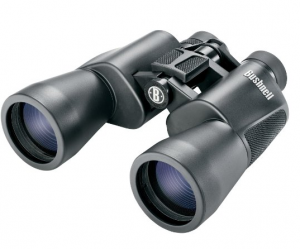 When it comes to binoculars, you only want the best, most rugged set you can get your hands on. They need to be reliable and able to take the abuse you might give them out in the wild, whether you’re exploring an untamed mountain side or searching for that deer you’re certain you just pegged. With the Bushnell PowerView Super High-Powered Surveillance Binoculars, you’ve certainly got a good start.
When it comes to binoculars, you only want the best, most rugged set you can get your hands on. They need to be reliable and able to take the abuse you might give them out in the wild, whether you’re exploring an untamed mountain side or searching for that deer you’re certain you just pegged. With the Bushnell PowerView Super High-Powered Surveillance Binoculars, you’ve certainly got a good start.
Huge Field of View
This set of enhanced spectacles comes with a 170-feet field of view at 1000 yards, giving 20x magnification with a 50mm objective diameter. To put that into perspective, an object a mile away would look like it was only 264 feet away. Best of all, they come with a 45 foot focusing distance; this means that you can focus them in on a specific object within your view. This makes them fantastic for spying on animals from far away.
One Touch Focus
Bushnell’s patented single touch focusing system helps to keep a specific object in very close focus with just a single touch. If your hands have a tendency to shake, this system will allow you to keep your target in view at all times, even if you can’t rely on yourself to hold still. The Insta-Focus works for moving targets, as well. This is a great set of binoculars for bird watchers.
Night Vision
Okay, so they don’t actually have ‘night’ vision – but things do seem a bit brighter when viewed through the lenses. This makes it much easier to see targets in the dim light of dusk, making these a great choice when hunting in the early morning or later in the evening. The lenses feature multi-coated optics which transfer light more effectively when there is less to transfer, allowing you to see more clearly.
Portable
At just 30 ounces, the Bushnell Powerview Surveillance Binoculars are easy to carry with you when you need them. They’re equipped with nonslip rubber armor. Not only are they easy to hold onto, but if you do happen to drop them, the rubber surrounding the binoculars will absorb the majority of the shock and keep them in one piece. These binoculars are designed to go long and hard in all conditions. When not in use, the fold-down eye cups will protect the lenses from harm.
Easy Set Up
The Bushnell Powerview Surveillance Binoculars have an initial set up that owners will need to go through when using them for the first time. Taking the time to do this helps you learn to use them quickly in the future, rather than spending precious time fiddling with the focus to get it just right. This set up also establishes your own papillary distance, setting the binoculars to work specifically for you rather than someone else.
Affordable
Starting at just $49.99, these binoculars are practically a steal. They come in a variety of sizes: 10x50mm, 12x50mm, and 20x50mm. The cost for each size varies depending on a number of factors, but the Bushnell Powerview is, on average, more affordable than comparably priced models.
No matter what you need a set of binoculars for, whether it’s hunting, paintball, or spying on people at the beach, this set won’t let you down. The Bushnell Powerview Surveillance Binoculars are a good entry-level set that isn’t likely to confuse beginners, making it a great gift for someone interested in getting a set of binoculars for themselves.
Tech Review: Bushnell G-Force DX ARC 6x 21mm Laser Rangefinder
A trusted name in optics, Bushnell’s G-Force DX ARC Laser Rangefinder combines ease of use with cutting-edge performance. This rangefinder is perfect for the experienced user, offering precision and clarity in a range of conditions. The G-Force DX ARC Laser Rangefinder is also good for the new user, boasting intuitive controls and quick response time.
The G-Force replaces the Bushnell Legend 1200 ARC rangefinder, a popular product with bowhunters that has now been discontinued.
Features
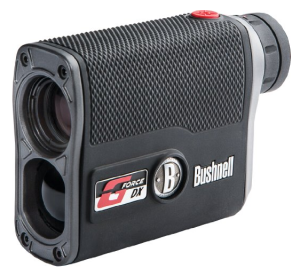 The G-Force DX ARC is built to last. Bushnell equips the rangefinder with a metal housing that holds up in rugged conditions. The rangefinder comes with rubber grips that provide comfort and slip-resistant handling in wet and cold conditions. Powered by a 3V lithium battery and weighing less than 8 ounces, the G-Force is light and easy to hold for long periods of time. It also fits easily into a pocket. With one-button operation and targeting, the G-Force is a cinch to use. With 6x optics, Vivid Display Technology, and an effective 5-1300 yard range, this rangefinder is clear and accurate. The V.D.T. yields peerless image clarity and great image contrast. With several light intensity settings, users can adjust the rangefinder to fit all outdoor lighting conditions.
The G-Force DX ARC is built to last. Bushnell equips the rangefinder with a metal housing that holds up in rugged conditions. The rangefinder comes with rubber grips that provide comfort and slip-resistant handling in wet and cold conditions. Powered by a 3V lithium battery and weighing less than 8 ounces, the G-Force is light and easy to hold for long periods of time. It also fits easily into a pocket. With one-button operation and targeting, the G-Force is a cinch to use. With 6x optics, Vivid Display Technology, and an effective 5-1300 yard range, this rangefinder is clear and accurate. The V.D.T. yields peerless image clarity and great image contrast. With several light intensity settings, users can adjust the rangefinder to fit all outdoor lighting conditions.
Pros
Bushnell’s second-generation E.S.P. technology makes the G-Force DX ARC quick and accurate. Shooters will find accurate ranging within a few feet. The response time between sighting and ranging is fast. With an integrated inclinometer and settings for both bow and rifle hunting, the G-Force provides precise readings for a variety of users. Bow hunters will find accurate horizontal distances, while rifle hunters will be able to use bullet-drop readings to maximize shot accuracy. With the tripod mount, Bushnell affords shooters stability over long outings.
Cons
Although the G-Force DX ARC allows users to adjust the intensity of its display, the red readout can be difficult to see in certain conditions. The single-button operation is effortless; however, the button that operates the rangefinder also selects the finder’s various modes and can be easy to bump. Finally, the $400 price tag may be a bit steep for some users.
Best Feature
This excellent rangefinder offers a wide array of shooting modes and angle range compensation. Angle range compensation allows for shot correction on the rangefinder itself. Rifle and Bow Modes help shooters scope accurate horizontal distances and account for bullet-drop and lag time. Brush Mode lets shooters to ignore foreground objects in order to range accurate background objects, and Bulls-Eye Mode offers the opposite experience. Shooters can range small foreground objects with precision and ease.
Worst Feature
Reviews suggest that red display on the G-Force DX ARC is the rangefinders biggest drawback. A black display would be easier to adjust and to read in a wide array of conditions. However, the overall performance of the G-Force DX ARC is strong enough that many users will be able to overlook this issue.
Most Unexpected Feature
This rangefinder is fully waterproof. The lens is coated in a water-repellant coating. Rain Guard HD makes the lens resist both water and fog as well as humidity-induced or early-morning condensation. Clarity and visibility are never compromised.
In Summary
Bushnell makes quality rangefinders, and the G-Force DX ARC is in a class by itself. With superior accuracy and image clarity, this range finder is easy enough for a novice shooter to use while still providing the cutting-edge technology and precision that experienced shooters demand. Durable and accurate in any condition, the G-Force DX ARC is costly. However, the performance of the G-Force more than compensates for its price. The G-Force DX ARC may be the only rangefinder a shooter ever needs.
Vortex Optics Diamondback 10×42 Binoculars Review
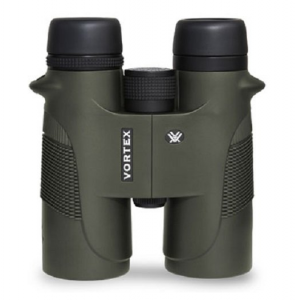 If you’re looking for a pair of versatile binoculars that can go toe-to-toe with much more expensive models, the 10×42 Diamondback by Vortex Optics may be just the perfect thing. The small details about this model, as well as the superior optics, make the Diamondback a popular choice for a variety of uses.
If you’re looking for a pair of versatile binoculars that can go toe-to-toe with much more expensive models, the 10×42 Diamondback by Vortex Optics may be just the perfect thing. The small details about this model, as well as the superior optics, make the Diamondback a popular choice for a variety of uses.
A little refresher course in optics here: the number 10 in the binocular configuration refers to the power of magnification. The 42 refers to the size of the objective (front) lens. Ideally, you want a combination of magnification and aperture that gives you a large, bright field of view without being too heavy, too unwieldy or too outlandishly expensive. The Diamondback 10×42 won’t disappoint in this regard.
At 24.4 ounces and 6.4 inches, these binoculars will fit in a field coat pocket and easily hold steady in your hand, yet give you great visibility even at dusk and dawn (345 feet at 1,000 yards).
Optical Quality
The Vortex Optics Diamondback 10×42 are roof prism binoculars, with phase correction to eliminate interference between different light phases reflected in the prism (known in optics as phase shift). What does this mean for you? Higher resolution and crisper contrast in every image because the fuzziness that can accompany phase shift has been corrected.
O-ring seals and argon gas purging keep the Diamondback 10×42 fogproof across a wide range of temperatures. They are waterproof, as well, which makes for a great set of hunting binoculars–you won’t miss a thing in the bush with this model.
Waterproofing and fogproofing are essential for birding, too. Don’t let anyone tell you otherwise. Even if you’re birding on a pristine, clear day, changes in temperature and humidity between the house, car and outdoors can cause fogging without a mechanism to prevent it. And of course, some of the world’s best birding takes place in dripping jungle habitat or by the spray of the sea.
Comfort & Design
Most folks will be taking the Diamondback 10X42 out for a full day of activity, so you want a model that’s comfortable and 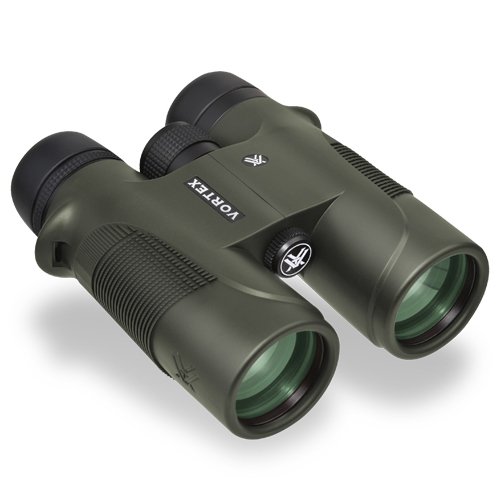 can handle the high use. With their forgiving eye cups, these binoculars will work with or without eyeglasses all day. The rubber outside casing offers a durable, non-slip surface for use with both bare hands and gloves. This is key if you’re going to be hunting in the snow or taking them to the nosebleed seats for some late-season football games up north.
can handle the high use. With their forgiving eye cups, these binoculars will work with or without eyeglasses all day. The rubber outside casing offers a durable, non-slip surface for use with both bare hands and gloves. This is key if you’re going to be hunting in the snow or taking them to the nosebleed seats for some late-season football games up north.
The Vortex Diamondback 10X42 Binoculars have a right diopter to adjust for the difference in vision between your two eyes, in addition to the center focus wheel. You can easily mount them on a car window, and they are also tripod adaptable.
Vortex: A Trusted Brand
If you’re comparing brands in binoculars, you’ll find that a lot of companies out there don’t just make binoculars; they make cameras, electronics and even jewelry and home goods. Vortex Optics specializes in sport optics, so you know they are pouring all their resources into a limited number of related products, like binoculars and rifle scopes. This allows them to offer an unconditional lifetime warranty on their products, the Diamondback 10X42 included. Available at under $300, this model is a steal when you compare it to comparable performance in other lines. Known for their customer service and attention to detail, Vortex Optics is rapidly developing legacy customers, to no surprise.
If you’re going to take your Diamondback 10X42 Binoculars into the field, you might want to consider a few extras. While this model comes with a molded carrying case and strap, a harness might serve you well over bumpy terrain or climbing your stand. Additionally, a lens cleaning kit will keep your binoculars in tip-top shape, so you can enjoy them for years to come.
Overall, there are few drawbacks to the Diamondback. There are still shadows that most binoculars have trouble with when you move them around sharply, but they aren’t a huge deal if you find some sort stabilizer (like a tripod) for them.
Celestron Skymaster Giant 15×70 Binoculars Review
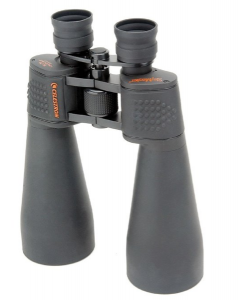 The Celestron Skymaster Giant 15×70 Binoculars include BaK-4 internal prisms and multicoated optics. These features produce improved vision with brighter resolution, which is of top importance for quality binoculars. Included with the Skymaster Giant 15×70 binoculars are a tripod attachment adapter and a soft carrier case. The imagery processing and visibility are top-notch. Celestron Skymaster Giant 15×70 Binoculars’ eyepieces are also excellent.
The Celestron Skymaster Giant 15×70 Binoculars include BaK-4 internal prisms and multicoated optics. These features produce improved vision with brighter resolution, which is of top importance for quality binoculars. Included with the Skymaster Giant 15×70 binoculars are a tripod attachment adapter and a soft carrier case. The imagery processing and visibility are top-notch. Celestron Skymaster Giant 15×70 Binoculars’ eyepieces are also excellent.
Key Specs
Let’s take a look at the overall power of these 70mm optics.
- 15x magnification
- Field of View (FOV)-4.4 degrees
- FOV at 1000yds-230
- Multi-coated lenses
- Diopter range- -4 to 8
- Close Focus Distance 52.5
70mm lens are some of the biggest lenses you can have on handheld binoculars. As a result, you have some of the greatest light gathering power on the market. The diopter settings range from -4 to +8, meaning you can adjust to low or high light situations.
Where some binoculars have trouble focusing and can have a tendency to shift, the Celestron Skymaster Giant 15×70 Binoculars have little to no wobble and are equipped with an amazing center-focus apparatus. In addition to this, the Celestron Skymaster Giant 15×70 Binoculars offer high quality eye relief at 18 millimeters, which is great news if you wear eyeglasses. You can adjust the eyepieces by taking the big cap off from the exit or objective lens and then looking through to adjust the focus of the center ring between the barrels until clear. You can do this for both the right and left separately to achieve optimum clarity.
These binoculars are lightweight but operate best when they are used with an attached tripod. The Celestron Skymaster Giant 15×70 Binoculars are optimal for a multitude of purposes, including stargazing at both the terrestrial and astronomical level and bird watching. They can be used during the day as well as during dusk. Although the size may make you rather noticeable, the Celestron Skymaster Giant 15×70 Binoculars can also be used at sporting events and concerts. The lightweight nature of the binoculars will allow you to utilize them almost anywhere with very low bounce rate.
The Celestron Skymaster Giant 15×70 Binoculars sport a 15x magnification and utilize very large 70 millimeter objective lenses. These lenses also assist in providing maximum brightness for both dimly lit and long-distance conditions. The Celestron Skymaster Giant 15×70 Binoculars have excellent across the field viewing with precise focus. Coated with a rubber protection layer, the Celestron Skymaster Giant 15×70 Binoculars are able to provide users with a no-slip firm grip.
Additional Features
In addition to these incredible features, Celestron Skymaster Giant 15×70 Binoculars also come with a no fault warranty which covers protection and support for the product. The warranty includes Celestron’s promise that all binoculars are free from defective material and that they are appropriate for a lifetime of usability. Celestron will replace or work to repair the binoculars if they are sent in, with prepaid postage and a proof of purchase. Celestron will replace or fix the binoculars, regardless of how they were damaged, without asking any questions.
The Celestron Skymaster Giant 15×70 Binoculars are one of Celestron’s most popular models in their Skymaster series, due in large part to their tremendous quality and lightweight functionality at such an affordable cost. The Celestron Skymaster Giant 15×70 Binoculars exact specifications include a 4.4 degree angular field of view, 4.7 millimeter exit pupil, the near focus is 43 feet, and the binoculars come with an IPD minimum of 56 millimeters and maximum of 72 millimeters. The Celestron Skymaster Giant 15×70 Binoculars come with caps, a strap, a nylon carrier, and a tripod adapter. The Celestron Skymaster Giant 15×70 Binoculars are also water resistant and weigh 48 ounces.
These are incredibly high quality binoculars at a very reasonable price that are perfect for the casual user or for those that are more experienced. Whether you plan to take these on a hike for bird watching, check out the night sky for some amazing star gazing, or a myriad of other purposes which require distance viewing, the Celestron Skymaster Giant 15×70 Binoculars are a perfect fit at an incredible value.
70mm lens are some of the biggest lenses you can have on handheld binoculars. As a result, you have some of the greatest light gathering power on the market. The diopter settings range from -4 to +8, meaning you can adjust to low or high light situations.
Uses
Since these binoculars are made by Celestron, you can already guess what they’re good at. The moon is one of the brightest objects in our night sky and with the 70mm’s variable diopter settings, you’ll have no difficulty seeing it up close when the sky is clear.
These diopter settings work the same during daytime and landscape viewing as well. They come with a tripod adapter as they do weigh about 3lbs free handed. Birding and nighttime sky watching are going to be the biggest and most logical uses for the 70mm’s. 70mm means that you’re going to soak up whatever is giving off light, notably objects in the sky and the moon.
Versus Other Sporting Optics
These binoculars are big, hence why more often than naught, you’ll see them hooked up to a tripod. They don’t make the best hunting binoculars because they are designed for extreme range viewing rather than detailed viewing. Remember, just because a pair of optics has big lenses, doesn’t necessarily mean you’ll get the best details of an object.
Swinging these binoculars isn’t going to be easy due to their size and weight. Compared to wide angled binos and other smaller sporting optics, the 70mm’s aren’t the most logical to take on hunts when you’re lugging them around for hours at a time. Unless you plan to stay in given area, you’re better off using a smaller pair.
Overall
It’s astonishing to note that the 15x70mm’s aren’t the biggest or smallest pair of binos in the SkyMaster series. Regardless, the 15x70mms sit in the middle of the SkyMaster series and provide astounding images for a cheap price compared to other Celestron products.
The 15x70mms don’t have the power to see stars or planets beyond the moon up close and personal but provide a sort of middle ground between mainstream sporting optics and telescopes.
Click here to shop the SkyMaster 70mm.
Optic Review: Rangemaster CRF 1600-B by Leica
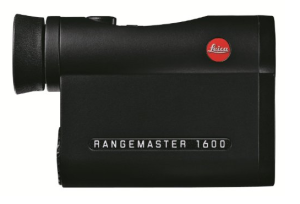 The Rangemaster CRF 1600-B from Leica makes some big promises as a range finder right out of the gate. It lives up to virtually all of them with only a few minor caveats. Despite a few cons that any honest review would mention, this rangefinder along with its advanced features is worth the extra money when compared to other equipment in its class.
The Rangemaster CRF 1600-B from Leica makes some big promises as a range finder right out of the gate. It lives up to virtually all of them with only a few minor caveats. Despite a few cons that any honest review would mention, this rangefinder along with its advanced features is worth the extra money when compared to other equipment in its class.
Features
The CRF 1600 comes with a considerable number of advanced features. However, this means that operation is slightly more complex than comparable units. Rangemaster took this concern into consideration, providing a one-touch operation mode for simple range measurements. The secondary button on the unit provides you with access to the more-advanced features. The actual range for the equipment is listed at 1,600 yards. At the outside edge of this number, the finder is only performing in top tiers when a reflective object is in the picture. Still, where gauging the distance of deer and trees are concerned, the abilities of this equipment are certainly impressive.
Before we get more in-depth into the accuracy and build, here’s an overview of the key features of the CRF 1600-B:
- Range: 10-1600 yards
- Integrated thermometer/barometer sensors
- Waterproof & fogproof
- Good light gathering capabilities & easy-to-read LED
- 7x magnification & wide FOV
- Adjustable eyecups
Accuracy
The accuracy of the CRF 1600 is par for the course. Up to 500 yards, you can count on being within your target reading by one yard on the outside. When reading distances closer to 1,000 yards, you may experience inaccuracy by as little as two yards. Above 1,000 yards, most experts have found that the accuracy hovers within plus to minus 0.5 percent. The number of benefits one can gain using this rangefinder are nothing to underestimate. On top of the outstanding range, the complete unit is extremely durable and well-suited for almost any environment. It goes on to provide atmospheric temperature and pressure readings as well.
Performance
The advanced features continue to expand in the various additional modes, offering users angles of inclination in relation to targets and potential ballistic curvatures once you have entered information concerning the particulars of ammunition. Another major selling point for this equipment is the optical clarity and its ability to gather light. It can collect visual information in a impressive array of environmental conditions in addition to presenting a stunning LED readout. The optics for the piece excel thanks to the inclusion of Aqua-Dura coating and P40 phase-correction coating. The result is a clear and crisp image in any setting as long as the temperature is between 14 and 131-degrees Fahrenheit.
Durability
The durability of the rangefinder is made possible by plastic that features carbon-fiber reinforcement. This coating is complimented by an interior chassis composed of cast aluminum. Maintaining the comfort of the piece is a soft lacquer finish on the exterior. Unlike many units developed over the past decade, there is no worry of fogging due to the fact that the most critical components are nitrogen-charged. The unit is also totally water tight for depths of up to one yard for a duration of under half an hour. Raw performance also adds to the list of strengths for this field companion. It auto-focuses in seconds, and the linear field of view is generous enough to allow you to locate and close in on targets rapidly.
Verdict
The versatility of the CRF 1600 is worth mentioning as well. The viewfinder features a rubber cupping that is retractable, compensating for use with corrective lens or the naked eye. Users also have the option of utilizing diopter compensation control in order to adjust the image sharpness for their individual eyesight. The piece is powered by a single 3V, CR2 battery. While this hardware is powerful, replacements can be hard to come by in most markets. All points considered, this rangefinder puts itself at the top of the pack when looking at the field as a whole.
Spotting Scope Review: Vortex Razor HD
Like Icarus, popular optics manufacturer Vortex is aiming high. Their Razor HD spotting scopes are designed to deliver super premium performance similar to market leaders in this class like Swarovski, Leica, and Zeiss. They want to do it at a fraction of the cost, too. Have they succeeded? Yes! Vortex’s spotting scopes soar high without getting too close to the sun.
Optical Features
The core of the Razor HD scope is a triple-apochromatic lens array designed to provide maximum clarity and minimal color aberration. The outermost lens has an AmorTek coating to protect against scratches, dirt, and corrosion. The inner lens elements are made of high density low dispersion glass, earning the scope its “HD” title.
The standard eyepiece on the scope is an adjustable 20-60x zoom model. A few alternatives are also available (see “accessories” below). The zoom adjusts smoothly. It has no presets, but it’s sturdy enough to hold any position it’s set to. At 1000 yards and minimum zoom the scope delivers a 117 foot field of view with this eyepiece; the maximum zoom FOV is 60 feet. The scope’s eyepiece mount is a standard bayonet system with an integrated button-release locking system.
Operation
Focus control on this scope is provided by a dual focus knob. This is a first for Vortex; the manufacturer has used single adjustments on all of its previous scopes. Vortex really knocked this feature out of the park on their first try. The coarse focus adjustment is truly coarse, taking the scope from its closest possible focus distance out to infinity in less than two full turns. This is fairly exceptional performance, and the fine adjustment knob also works smoothly.
Razor HD scopes have some very nice operational features that make them a real joy to use in the field. There’s an integrated lens hood to minimize lens flare and a basic sighting tube attached to the lens mount. The lens caps are sturdy and fit tightly; in fact the objective lens cap is extremely snug.
Construction
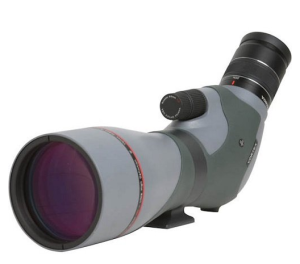 Vortex has released the Razor HD in both straight and angled versions to suit the needs of different users. (Angled spotting scopes are often preferred by prone and range shooters, while those more interested in straight glassing find straight scopes more convenient.) The straight version of the scope is about a half-inch longer than the angled one; they’re otherwise identical.
Vortex has released the Razor HD in both straight and angled versions to suit the needs of different users. (Angled spotting scopes are often preferred by prone and range shooters, while those more interested in straight glassing find straight scopes more convenient.) The straight version of the scope is about a half-inch longer than the angled one; they’re otherwise identical.
These scopes are completely sealed and purged with argon to prevent internal fogging and water intrusion. The frame is made of a magnesium alloy to reduce overall weight. The armored body of the scope is grey with a dark green textured overlay around the prism housing, making handling a little easier.
Accessories
The manufacturer offers a few extra eyepieces to expand the versatility of the Razor HD scope. These include a 30x fixed magnification wide-angle eyepiece and a 23x long eye relief model ideal for range use. Vortex also makes an excellent camera adapter for digiscoping that fits multiple cameras from point-and-shoot models up to full DSLRs.
Vortex’s case deserves special attention. A very good zippered, padded case is included with the scope itself. This case has multiple high-quality zippers allowing access to the lens, eyepiece, and tripod mount without removing the case, making the scope fully usable. It has two carrying handles and a removable shoulder strap.
Advantages
- Price! The current suggested retail price of the Razor HD spotting scope is just $2000. It easily delivers performance comparable to much more expensive models while costing only half as much.
- Versatility. The quick focus adjustment and simple controls make this an ideal scope for use with moving targets. The availability of both straight and angled models makes it easy to match the scope to the user’s needs, too.
- Comes with a great case. A padded, durable case that allows you to operate the scope without removing it should normally cost one to two hundred dollars. Vortex throws it in for free.
Drawbacks
- Performance at extreme focus is slightly lacking. Pushing all the way up to 60x zoom results in some minor image degradation and color aberrations. This is normal for high-zoom scopes, though.
- Tight fits on both the objective lens cap and the eyepiece mount. Removing the lens cap for the first time is a real struggle, and most users will likely elect not to replace it fully. The socket for the eyepiece is similarly a very tight fit, requiring a little force to lock the eyepiece into place.
Conclusion
While Vortex’s Razor HD spotting scopes aren’t without flaws, there is no alternative scope that overcomes them at a price that’s anywhere close to the Razor’s. This scope offers outstanding premium performance for just $2,000; Buying an even better scope can easily cost twice that much or more. This makes the Razor HD a superb choice for spotters who want outstanding optics and great reliability without a sky-high price tag.
Spotting Scope Review: Kowa Prominar ED TSN880
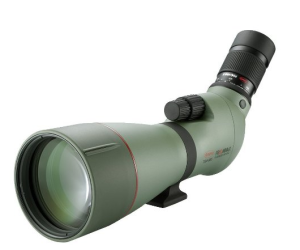 For an 88mm scope, this Kowa is remarkably small. At just over 13 inches without the eyepiece, it’s very compact. The scope is also relatively light, at 53.6 ounces, due to the use of Magnesium alloy for the scope body. With the eyepiece installed, the scope is 16 inches long and weighs 65 ounces. The small size and weight of the Kowa means that it’s possible to use a lighter and more compact tripod, which is a nice option to have.
For an 88mm scope, this Kowa is remarkably small. At just over 13 inches without the eyepiece, it’s very compact. The scope is also relatively light, at 53.6 ounces, due to the use of Magnesium alloy for the scope body. With the eyepiece installed, the scope is 16 inches long and weighs 65 ounces. The small size and weight of the Kowa means that it’s possible to use a lighter and more compact tripod, which is a nice option to have.
Optical Qualities
The bright, ultra-sharp image is the most impressive quality of the Prominar ED. The image is distortion free, and can be owed to the superior quality of glass used by Kowa. The objective lens of the ED uses Pure Fluorite Crystal, which contributes to the claimed 99%+ light transmission. After looking through the scope, I don’t doubt the truth in that claim.
The Kowa is focused through two focus controls along the same axis. The large knob is for coarse adjustments, and the small knob is for fine tuning for achieving the remarkably sharp image this scope is capable of. It’s a good system for focusing, and I got used to it pretty quickly.
The Kowa Prominar ED is designed to function in all weather conditions. To help achieve this aim, the body is nitrogen-purged and fully sealed with a waterproof housing. I wouldn’t test this without need, but it’s nice to know that rain won’t be a problem. One quality to make note of, particularly if you are hard on your scopes, is that the ED does not have a rubber armor coating. This keeps weight down, but renders the scope more vulnerable to impacts and vibrations. Padded covers are available from Kowa, however.
Field Test and Range Results
The first time I used the Kowa, I compared it to a Pentax PF100-ED, a highly respected scope in its own right. In comparison, I was very impressed by the Kowa’s optical clarity, particularly at the lower powers. I have a pile of logs I keep near a garden shed about 150 yards away from my house, for the rural Washington state winters. I pointed the Kowa at them, focusing on the end of one of the logs. I could see the growth rings, and easily count them, with both scopes. However, the Kowa was unquestionably clearer. The difference in quality is hard to describe, but it is significant. It’s like the difference between a hazy day and a clear day in the city.
I’ve taken to using the Kowa at the range these last few weeks. In as many different weather conditions as possible, and alongside as many scopes as I could get my hands on, I tested the Kowa Prominar ED to see how it measured up. The Kowa out-performed every scope I compared it to, and excelled in every weather condition. From counting the bullet holes in targets hundreds of yards down range, to reading the small details on eye charts at range, the Kowa consistently outperformed its testing partners.
Overall Assessment
The Kowa is excellent in every way. It’s the best I’ve ever looked through, bar none. But you pay for that quality. The question is, is the Kowa Prominar ED 88mm really worth almost $1000 more than the Pentax PF100? That’s for you to decide, but for me the question is a resounding yes. I decided it was worth the price, and purchased one. I now use it in every situation I can, and I love its unmatched clarity and the ease of use that comes with its design.

